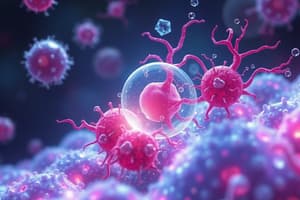Podcast
Questions and Answers
Quel processus évolutif est illustré par la relation symbiotique où un organisme vit à l'intérieur d'un autre?
Quel processus évolutif est illustré par la relation symbiotique où un organisme vit à l'intérieur d'un autre?
Quel est un exemple classique d'endosymbiose?
Quel est un exemple classique d'endosymbiose?
Comment le Elysia chlorotica utilise-t-il les chloroplastes qu'il acquiert?
Comment le Elysia chlorotica utilise-t-il les chloroplastes qu'il acquiert?
Quel est le terme utilisé pour décrire l'acquisition de chloroplastes en provenance d'une source externe?
Quel est le terme utilisé pour décrire l'acquisition de chloroplastes en provenance d'une source externe?
Quelle caractéristique des chloroplastes de Elysia chlorotica les différencie de ceux des plantes?
Quelle caractéristique des chloroplastes de Elysia chlorotica les différencie de ceux des plantes?
Quel est l'impact métabolique de l'absorption des chloroplastes par le Elysia chlorotica?
Quel est l'impact métabolique de l'absorption des chloroplastes par le Elysia chlorotica?
Qu'est-ce qui soutient la théorie de l'endosymbiose concernant l'origine des mitochondries et chloroplastes?
Qu'est-ce qui soutient la théorie de l'endosymbiose concernant l'origine des mitochondries et chloroplastes?
Quelle affirmation est vraie concernant le rôle des chloroplastes dans les plantes par rapport à Elysia chlorotica?
Quelle affirmation est vraie concernant le rôle des chloroplastes dans les plantes par rapport à Elysia chlorotica?
Quelle expérience mettrait en évidence la photosynthèse possible d'Elysia
Quelle expérience mettrait en évidence la photosynthèse possible d'Elysia
L’objectif des scientifiques est de mettre en évidence
L’objectif des scientifiques est de mettre en évidence
Flashcards
Endosymbiose
Endosymbiose
Un processus évolutif majeur où un organisme vit à l'intérieur d'un autre, bénéficiant tous les deux de la relation.
Mitochondries
Mitochondries
Organelles cellulaires responsables de la production d'énergie dans les cellules eucaryotes.
Chloroplastes
Chloroplastes
Organelles cellulaires responsables de la photosynthèse dans les cellules végétales.
Théorie endosymbiotique
Théorie endosymbiotique
Signup and view all the flashcards
Elysia chlorotica
Elysia chlorotica
Signup and view all the flashcards
Kleptoplastie
Kleptoplastie
Signup and view all the flashcards
Chloroplastes fonctionnels
Chloroplastes fonctionnels
Signup and view all the flashcards
Plasticité métabolique
Plasticité métabolique
Signup and view all the flashcards
Photosynthèse chez Elysia chlorotica
Photosynthèse chez Elysia chlorotica
Signup and view all the flashcards
Différences entre les plantes et Elysia chlorotica
Différences entre les plantes et Elysia chlorotica
Signup and view all the flashcards
Study Notes
Endosymbiosis
- Endosymbiosis is a significant evolutionary process where one organism lives inside another, benefiting both.
- This relationship frequently fosters evolutionary adaptations.
- A prime example is the origin of mitochondria and chloroplasts within eukaryotic cells.
- Mitochondria and chloroplasts are believed to have evolved from free-living prokaryotes.
- Evidence for this theory includes the double membrane structure of these organelles, their unique circular DNA, and their ribosomes resembling prokaryotic ribosomes.
- Endosymbiosis showcases how evolution can be driven by the interaction and integration of diverse organisms.
The Elysia Chlorotica Case Study
- Elysia chlorotica, a sea slug, offers a fascinating example of endosymbiosis involving chloroplasts.
- This sea slug consumes algae, specifically Vaucheria species.
- The slug selectively absorbs chloroplasts from the algae.
- Chloroplasts remain alive and functional within specific cells of the slug's body.
- These chloroplasts continue photosynthesis for several months, providing the slug with some energy.
- This allows the slug to reduce its reliance on food, representing a notable metabolic adaptation.
- The chloroplasts aren't integrated into the slug's cellular machinery in the same way as in plants (lacking genetic encoding).
- This unique example of kleptoplasty (acquisition of chloroplasts from an external source) showcases flexible metabolic plasticity.
- This exceptional adaptation highlights the dynamic nature of evolutionary relationships and metabolic pathways.
- The slug's capacity to persist with chloroplasts in its cells exemplifies a remarkable adaptation within the animal kingdom.
- This case study illustrates the symbiotic nature of certain organisms and their evolutionary progress.
Key differences between plant and Elysia chloratica chloroplasts:
- Elysia chlorotica differs fundamentally from plants regarding chloroplast acquisition and utilization.
- Plant chloroplasts are integrated into their cellular machinery.
- Elysia chlorotica does not incorporate the chloroplasts into its genome.
- Plants rely on chloroplasts for energy production through photosynthesis, crucial for their lifecycles.
- Elysia chlorotica benefits from chloroplast photosynthesis capabilities, offering energy advantages but not complete survival sustenance over extended periods, as it lacks the complete physiological machinery needed. Its survival depends on other factors.
Evolutionary Implications of Endosymbiosis
- Endosymbiosis has played a critical role in the evolution of eukaryotic life.
- It underscores the significance of symbiotic relationships in shaping the tree of life.
- The Elysia chlorotica case highlights how evolutionary pressures can drive remarkable metabolic adaptations.
- These occurrences provide insight into the flexible and dynamic nature of organismal metabolic adaptations.
Studying That Suits You
Use AI to generate personalized quizzes and flashcards to suit your learning preferences.




